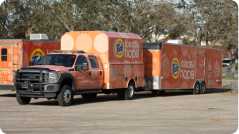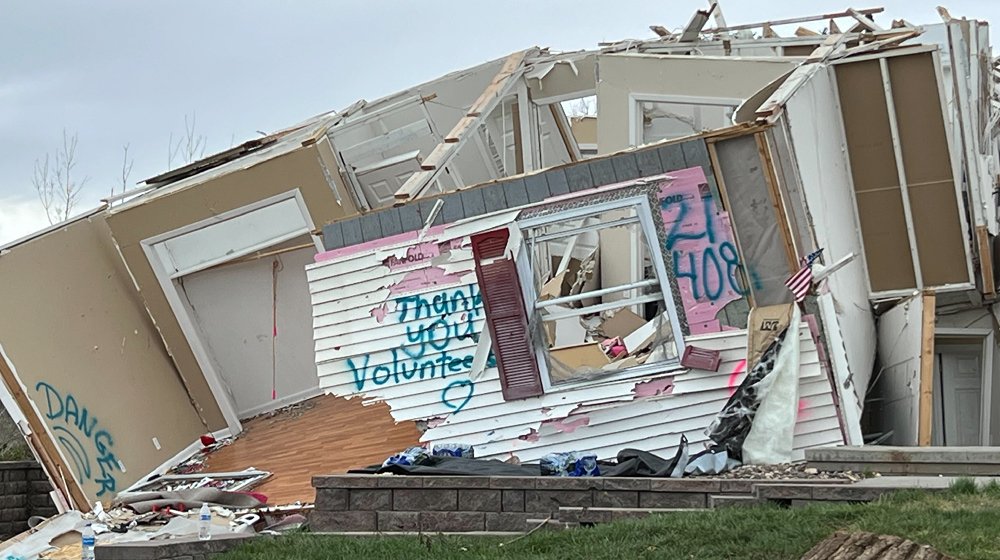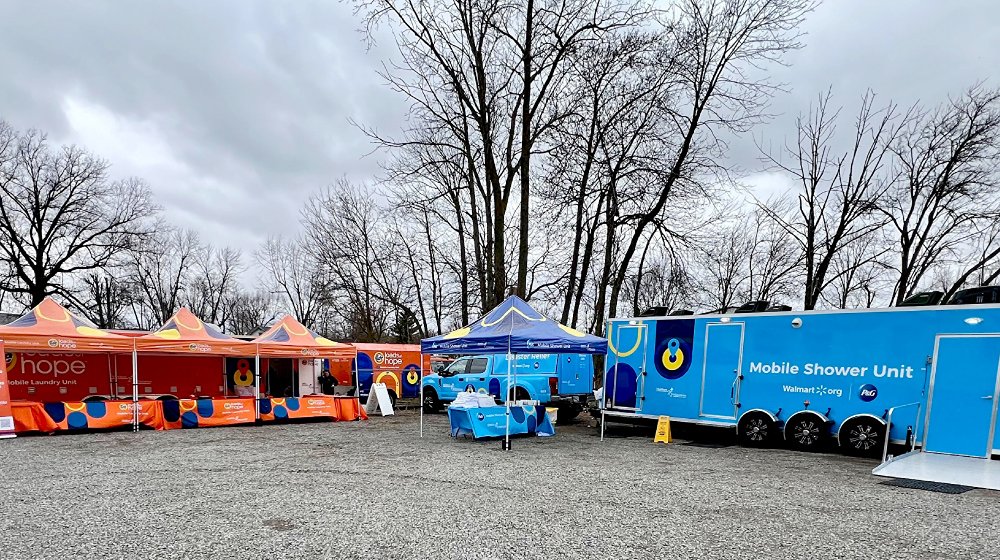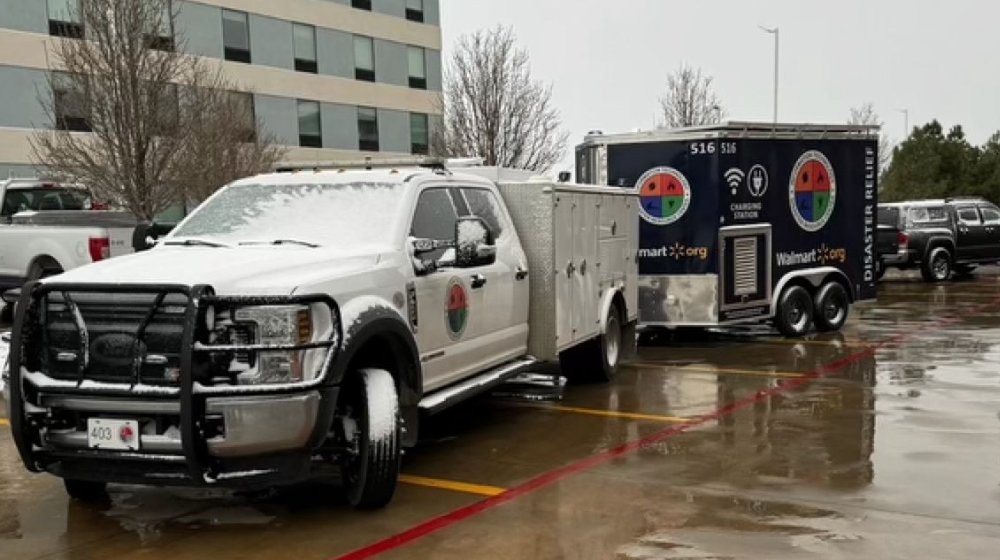Disaster Preparedness and Response

GRI: 3-3, 201-2
UN SDG: 11
S G
Published: Oct. 24, 2024
At a Glance
- Walmart’s strengths as a retailer and physical presence in communities make us an early destination for customers and members to access critical products and services and a hub for organizations to distribute critical food and supplies in times of disaster.
- Walmart takes a comprehensive approach to disaster preparedness and response, prioritizing the well-being and recovery of our customers, associates, and communities.
- Walmart and the Walmart Foundation have provided more than $55 million for disaster preparedness and response and relief efforts supporting communities around the globe over the last three fiscal years.
We aim to effectively prepare for and respond to disasters, with a focus on associate well-being, serving customer needs, and supporting impacted communities.
Disasters impact store and club operations, our associates, our customers and members, and communities where we operate. Effective preparation and mitigation make our business more resilient and help our associates, customers and members, and communities thrive.
To enhance resilience and help respond to and mitigate impacts of disasters, our approach includes:
- Advance planning and preparation: Support preparedness in our facilities and communities; and
- Disaster response and recovery: Deploy resources centered on associates, customers and members, and communities.
Supporting Our Stakeholders
Associates
Ensuring the well-being of our associates and their families
Customers and Members
Maintaining and restoring our operations to serve customers and members swiftly and safely
Communities
Helping vulnerable communities build resilience before disasters and supporting impacted communities after disasters
Advance Planning and Preparation
Recognizing that disasters could adversely affect our business performance,1 Walmart invests in disaster planning and preparedness, including risk assessments, business continuity and crisis management planning, and training. Additionally, Walmart supports communities’ disaster preparedness and resilience programs, focusing on disaster-prone areas with underserved populations.
Disaster Risk Scanning
Our Global Emergency Management (GEM) team, staffed by Walmart associates with experience in law enforcement, meteorology, emergency management, and resilience planning, uses data to identify, assess, and manage events that could affect our operations, supply chain, or associates. For example:
- We gather information from government authorities regarding emergency declarations at the federal, state, county, and city levels and make the information available to our business to evaluate whether action is necessary.
- Using data from the National Hurricane Center and Weather Prediction Center, we assess risks from developing events—such as hurricanes and ice storms—several days in advance of impact so that we can build and implement plans for the areas we anticipate will be most impacted.
- We use data from previous events to anticipate customer and community needs, help us determine where we may need to direct necessary supplies and personnel, prepare associates in the field with knowledge about available resources, and help inform plans to maintain or quickly restore operations if similar situations arise in the future.
Building Enterprise Resilience
Our enterprise resilience process aims to equip Walmart's business units to respond to business disruptions and crises in an efficient and cohesive manner. The GEM team facilitates these efforts by engaging with and training business units to implement and update business continuity and crisis plans. We regularly test our crisis/incident management plans through mock scenarios and tabletop exercises; these exercises help us learn and identify improvements that we integrate into our plans.

Disaster Preparation for Associates
Our associates play a critical role in disaster planning and preparation and receive role-specific training in crisis management and business continuity planning, processes, response, and recovery procedures, including participating in hands-on preparedness exercises.
Walmart also offers training and resources to help associates prepare themselves and their families for emergency or crisis situations. For example, we offer online training and resources on how to create a personal emergency plan, which includes establishing communication plans, building an emergency supplies kit, and setting a family meeting place.
Disaster Preparation for Customers and Members
Because so many customers and members rely on Walmart for essential products and services—particularly in times of disaster—we prepare for potential disasters that could affect their safety and access to essential products and services. We keep them informed about events that may impact their area and stock essential products needed before, during, and after events. Our facilities also prepare to minimize disaster impact, enabling swift and safe resumption of operations.
Example preparatory activities include:
- Pre-shipping truckloads of water and other needed products to stores and clubs
- Changing TV broadcasts within stores in impact zones to show weather forecasts or disaster preparedness videos
- Conducting roof checks and facility walks to identify and address potential damage points
- Pre-staging refrigerated trailers and mobile generators at locations that are at risk of losing power
Disaster Preparation for Communities
Walmart and the Walmart Foundation help support organizations working to help communities—particularly those at risk of being disproportionately impacted—prepare and become more resilient.
Supporting Community Disaster Preparedness and Resilience
Starting in FY22, the Walmart Foundation invested more than $3 million to help underserved communities—particularly in areas prone to weather-related disasters and where resources are not always available—build the capacity to respond to disasters more effectively and equitably.
Initial learnings from those grants highlighted prospective areas for further focus, such as:
- Augmenting local-level capacity and expertise to access disaster mitigation resources;
- Helping disaster preparedness organizations engage in ways that build trust with underserved communities; and
- Supporting local leaders and institutions in prioritizing programs for their most vulnerable community members.
Seeing the potential positive impact of further disaster resilience initiatives, along with the federal designation of Community Disaster Resilience Zones (CDRZs) across the U.S., the Walmart Foundation made more than $3.5 million in additional disaster resilience grants in the past year. This fresh round of funding included grants to organizations including St. Bernard Project (read more about the Walmart Foundation’s support of SBP below), Geos Institute, and the Urban Institute.
Supporting Disaster Resilience with St. Bernard Project
The St. Bernard Project Resilience and Recovery Fellows Program—a Walmart Foundation-funded project from our 2021 Gulf Region investments—showed promising results. The program supported the placement of Fellows to assist local communities in applying for and receiving disaster preparedness and recovery funds. A Fellow working with the City of Lake Charles, Louisiana helped the city to obtain a $40 million HUD Choice Neighborhoods Grant in 2023 to support the city’s recovery and rebuilding efforts after four natural disasters hit in the course of a single year.
Following on this success, the Walmart Foundation made an additional $2 million grant to SBP to support the appointment of additional Fellows working in communities in Alabama, Florida, Mississippi, South Carolina, and Texas.

Preparing Stores and Clubs to Support Communities
While each disaster and each community is unique, Walmart takes action to prepare our local store and club operators to be ready to meet community needs in a broad range of disasters. Walmart’s Disaster Response Guide provides foundational information about Walmart's community disaster support resources, including donating products and gift cards to nonprofits involved in recovery efforts, parking lot activations, and customer/associate giving campaigns. The Guide also provides best practices for store and club operators to foster relationships with local emergency managers, public officials, and community nonprofits ahead of any disaster, ensuring that our operators already have lines of communication open with these organizations.

Disaster Response and Recovery
When disasters occur, Walmart focuses on the well-being of associates and their families; recovering store and club operations swiftly and safely; and supporting impacted communities.
Activating Walmart's Emergency Operations Center
Walmart’s Emergency Operations Center (EOC) operates 24/7, 365 days per year and serves as the central command center for preparation and response. The EOC fields calls and reports of incidents every day from Walmart's stores, clubs, and facilities worldwide, including natural disasters and other events that could impact Walmart associates, operations, and communities. EOC team members assess and triage each situation, offer guidance to responding associates, and coordinate support.2 The EOC can respond to events virtually or physically, assembling support teams around the clock.
Depending on the nature of the disaster, the EOC can activate a cross-functional team to coordinate store and club operations, supply chain, human resources, philanthropic, and other activities across the company.
EOC team members are regularly deployed to local and state EOC locations, embedding onsite with local emergency managers, government responders, and other organizations to facilitate communication on the latest forecast and impacts, coordination of response and recovery efforts, priorities, and support needs.
After each event, the GEM team conducts after-action reviews to identify lessons for continuous improvement. Valuable information and recommendations from after-action reviews are incorporated into our future disaster preparedness and response plans.
Explore the gallery below to see examples of how Walmart supports associates, customers and members, and communities during a disaster activation: this example follows our response during Hurricane Ian in 2022.
Hurricane Ian Preparation and Response Timeline
Establishing the Well-Being of Our Associates
In the wake of a disaster, our GEM team works with our Facilities and People teams to check on the well-being of our associates and their families and connect them to resources they may need. Through OneWalmart.com, our associate-facing website, we provide recommendations and best practices for what to do before, during, and after a natural disaster or when a store experiences a security threat or other business disruption. Real-time updates are shared with associates by email, OneWalmart.com, and through an associate hotline, which is automatically updated and tailored to the caller’s work location.
Following a disaster, we conduct associate wellness checks, directly reaching out to associates in the most impacted areas to assess their well-being and connect them to resources. In situations where multiple Walmart locations are impacted, this outreach could include thousands of associates.
Walmart provides evacuation assistance for associates who must leave their homes due to mandatory evacuation, as well as opportunities to work in nearby stores and clubs should their regular Walmart location temporarily close.
Maintaining and Resuming Operations for the Customer and Members
Customers and members rely on Walmart’s more than 10,500 stores and clubs for essential products and services during times of disaster, so we aim to restore operations swiftly and safely. Often, we are able to begin serving communities in need while response agencies are simultaneously working to establish relief operations.
Recovery activities include:
- Publishing on Walmart's website which stores and clubs are open, closed, or have modified hours or services
- Assessing properties and buildings for water damage, flooding, roof damage, or other issues and deploying technicians and experts who restore our facilities to operational status
- Assessing the safety and viability of transportation routes to facilities in the impacted area so that we can resume deliveries of products to stores and clubs and reroute if necessary
- Connecting facilities to generator power: Mobile generators kept stores, clubs, and distribution centers powered for more than 11,000 hours while grid electricity was unavailable in 2023, helping to make our facilities available to customers and members when they needed food, pharmaceuticals, and other necessary items.
- Designating fuel lines for associates and first responders to be able to fuel vehicles and generators
Supporting Impacted Communities
Walmart is often the first destination after a disaster, and we draw on our strengths as a retailer to support relief efforts. Often, communities need more than an open store or club, and we are also committed to helping meet those needs.
Since FY2022, Walmart and the Walmart Foundation have provided more than $55 million in cash and in-kind for disaster preparedness, response, and relief efforts supporting communities around the globe, including more than $15 million in FY2024.3
Because each disaster is unique, our Walmart.org and emergency management teams coordinate with response organizations on the ground and relay real-time information back to our EOC. We use this information to determine the level and nature of support needed, which can range from using our space to coordinate services and product donations (such as food and water), to fast and flexible-use gift cards to local nonprofits to enable them to immediately procure critical supplies, to major grants to relief organizations and community foundations.
Disasters often disrupt utilities, leaving community members without access to basics like hot meals, warm water, and the ability to charge their phones. In some instances, Walmart is able to support access to these resources through parking lot activations. Walmart.org has provided grants to several nonprofits to launch a fleet of disaster response vehicles that can be deployed to disaster-struck areas, offering crucial services such as laundry facilities, showers, Wi-Fi and phone charging, and hot meals. These innovative mobile assets, which are now deploying to disaster areas around the U.S., swiftly respond and set up in places like our parking lots, providing a place of comfort and resources for community members.
Click on "Disaster Response" below to read more about Walmart’s support of communities during significant disaster activations.
- While we use available data to prepare for and anticipate severe weather and other disruptions, these events are inherently unpredictable. Moreover, storm intensity, frequency, and unpredictability are expected to increase with climate change.
- The primary way we serve communities is by operating our business; our success in serving communities in times of disaster and disruption is, therefore, dependent on our ability to keep operating and/or resume operations.
- Stakeholders and communities have more needs than Walmart can meet alone, creating the need to focus on our core capabilities and collaborate to extend impact.
- Successfully serving communities and recovering from disasters and disruptions are dependent on the engagement of associates, suppliers, and customers and members. Associates serve our customers, suppliers produce and distribute products, and customers and members contribute to relief efforts.
- Disasters disproportionately impact underserved communities that tend to be both the most exposed to damages from an event and the least able to recover financially.
1. As stated in Walmart’s annual report on Form 10-K.
2. Adapted from FEMA’s National Response Framework
3. Walmart's donations toward disaster recovery and relief efforts fluctuate from year to year in response to the needs of our communities and the frequency and severity of disaster events. For example, FY2022 numbers were substantially elevated due to Walmart's contributions to COVID-19 response causes.























